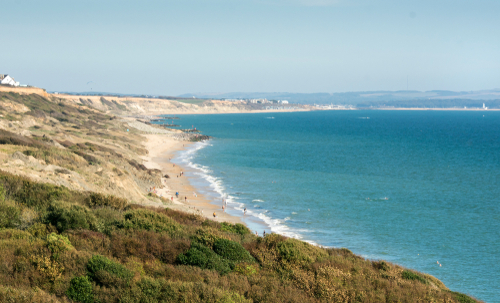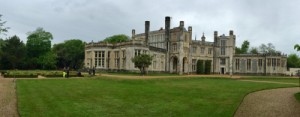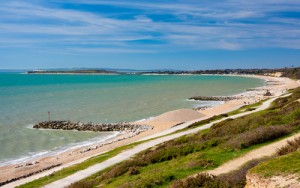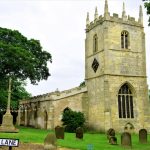
Highcliffe in Brief
Highcliffe, sometimes known as ‘Highcliffe-on-Sea’, is a large village in Dorset in southwest England. It lies 8 miles east of Bournemouth and 18 miles southwest of Southampton. It forms a parish with the village of Walkford, which is part of the South East Dorset conurbation. Situated on the English Channel coast, Highcliffe is just 9 miles to the northwest of the Isle of Wight. The village is most famed for its historic castle, which helped it became a popular tourist destination during the late 19th century. In 2019, the population of the Parish of Highcliffe and Walkford was estimated at 13,529.
A Fleeting History
High Cliff
Botanist John Stuart, the 3rd Earl of Bute, visited the Dorset coast for the first time in the early 1770s. He was immediately captivated with the area. So much so, that in 1773, he commissioned a mansion to be built at a raised coastal location. However, some 20 years later, the grand ‘High Cliff’ house had to be demolished, due to coastal erosion.
In 1830, Charles Stuart, Lord Stuart de Rothesay, bought back part of his grandfather’s Highcliffe estate. The land was to be the site on which he would build his dream home. He employed the notable 19th-century architect William Donthorne to design the grandiose house. The Gothic Revival buildings became known as Highcliffe Castle. Most of its authentic Medieval stonework and stain-glass windows were salvaged from a French monastery.
Highcliffe Castle and Newtown
Also in 1830, Captain Hopkins of nearby Hoburne bought a field at Slop Pond. He built around twenty houses to accommodate local farm workers and fishermen. The new residents were not particularly happy with the Slop Pond moniker, so the village’s name was changed to Newtown.
Newton soon expanded onto land which had formerly been part of the original High Cliff estate. The village then quickly became known as Highcliffe. And soon, the village name changed again, when it became known as Highcliffe-on-Sea.
In 1843, Lord Stuart de Rothesay, donated land to the village on which the Church of St Mark was built. In 1869, an evening school was opened in the village for boys aged 13 to 21 years old. The weekly school fee was 2d (1p) for three evenings of tuition a week. In 1882, Lady Waterford, the owner of Highcliffe Castle, opened a temperance lodge in the village. The mission, amongst other things, served up milk. The aim was to convert villagers to a healthy lifestyle in a bid to curb alcohol consumption.
In 1887, the county celebrated Queen Victoria’s golden jubilee. Lady Waterford funded a slap-up meal, a fete, and fireworks display for Highcliffe’s 320 parishioners. She also donated money for a village hall, The Jubilee Reading Room, to commemorate the Queen’s 50-year reign. In 1888, the village’s reputation took a leap when then PM William Gladstone visited Highcliffe. He and his wife spent a weekend as guests of the Stuarts at Highcliffe Castle.

The impressive Highcliffe Castle. Credit: Seanseyeview/Shutterstock.com
Highcliffe in Change
On 6 March 1888, Hinton railway station opened on the main South West Line (SWL) to Waterloo. Just over a mile from Highcliffe, the arrival of the railway helped kickstart the town’s tourist industry. Later in the year, the station’s name was changed to Hinton Admiral, which remains unchanged to date. The name was derived from nearby Admiral House, whose owner also owned the land on which the station stood.
In 1892, the village name was officially changed back to Highcliffe. In 1897, the 2,615-acre civil parish of Highcliffe was created from parts of the neighbouring areas of Christchurch and Milton.
By the beginning of the 20th century, ownership of Highcliffe Castle had passed to Edward Stuart Wortley. By this time the castle had earned a reputation as being a sanctuary for the rich and famous. In 1907, Kaiser Wilhelm II of Germany famously stayed for three weeks at the castle. As well as much-needed respite, he wanted to experience ‘the life of an English gentleman’.
In 1908, parishioner John Frampton donated a piece of land on which the village’s Methodist chapel was built. Highcliffe caught up with the times somewhat in 1924 when street lighting was installed. In 1932, the parish council purchased land for the Recreation Ground from Highcliffe Castle owner General Stuart Worsley.
World War 2 and Beyond
During World War 2, Highcliffe and the surrounding area experienced a number of bombing and enemy fire incidents. On 30 April 1944, a Thunderbolt aircraft crash-landed in the school playground. The war saw 24 servicemen and a nurse from the Highcliffe area make the ultimate sacrifice.
In 1949, the local golf club managed to purchase land from the Stuart family. The castle and estate were sold the following year which saw it become a children’s home for a short while. Ownership of the castle then passed to the Roman Catholic Claretian Fathers who were in residence between 1953 and 1967. The castle was then bought by a group of local businessmen. However, shortly after the purchase, the castle suffered a major fire. The abandoned building, exposed to the weather and vandals, soon fell to wreck and ruin.
The Modern Era
In 1977, Christchurch Borough Council purchased the Grade l listed Highcliffe Castle for £65,000. A decade later they also spend around £350,000 to create Highcliffe Beach. In 1994, the council secured a grant of £2.6 million from the Lottery Fund to finance a major restoration of Highcliffe Castle.
Highcliffe is a busy and prosperous village, where the economy is heavily reliant on the service sector, including tourism. There are certainly plenty of pubs, bars and restaurants in the area. There’s also a great number and wide variety of shops. The 16 wildlife sites, nature reserves, and SSSIs, in the local area, means that the village attracts visitors all year round.
The Highcliffe Food and Arts Festival is the biggest event in the local calendar taking place annually in June. The two-day event showcases local food, beverage, and arts and crafts. There’s also the usual music and entertainment.
Getting to Highcliffe
By Road
From London take the M3, M27 and A31. At Ashley Heath roundabout take the A338 for Bournemouth. Next, take the A338 for Christchurch as you approach Bournemouth. As you approach Christchurch, take the bypass, which leads onto the A337 (Highcliffe Road). From the North, it’s probably easiest to follow the motorway network and join the M3 at Winchester.
By Rail
The train station that serves Highcliffe is Hinton Admiral. Just over a mile away, it’s a stop on the South Western Main Line from London Waterloo to Weymouth. Services are operated by South Western Railway and depart for London approximately every 30 minutes. From the Midlands and the North, it’s probably easiest to change at Bristol.
By Air
Bournemouth Airport is located just over 7 miles northwest of Highcliffe.
Things to see and do!
Highcliffe Castle
Highcliffe Castle is a Grade I listed building often described as ‘the best remaining example of 19th-century Romantic architecture. The exhibitions and displays tell the story of the castle itself and the surrounding area. Set in 14-acres of grounds it’s a popular spot for walkers and picnickers, alike. Various events take place in the castle and its picturesque grounds throughout the year.
Motorbikes and Alpacas
Just 2 miles from Highcliffe, the Sammy Miller Motorcycle Museum houses one of the world’s best collections of vintage motorcycles. The ever-growing collection has more than 400 unique and classic motorcycles on display. The neighbouring courtyard has cafes, craft shops, and a children’s play area. There’s also farm holding with chickens, donkeys, goats, alpacas, etc.
Chill at the Beach!
Highcliffe Beach is an immaculately clean and relatively quiet beach. Like most beaches in the area, it’s a mix of sand and shingle. Facilities include a nearby restaurant and takeaway, and lifeguard service, during the summer months. There are also several other beaches a little further along the coast towards Christchurch. Avon Beach and Friar’s Cliffe Beach are the closest, the most popular locally, and have the most amenities.

Highcliffe Beach. Image Credit: Ian woolcock/Shutterstock.com
Back to Nature!
Steamer Point is a 24-acre local nature reserve (LNR). It’s situated on the clifftops between Highcliffe Castle and Friar’s Cliff coastline. The reserve includes both woodland and marine habitats and supports a wide variety of flora and fauna. In total, there are 15 other various wildlife sites, nature reserves or SSSI’s in the local area.
All Aboard!
If you fancy taking to the water you can rent a boat from Quay Leisure Boat Hire at Christchurch quayside for as little as half an hour. Boats carry up to 6 passengers, you don’t need any experience or license. and you can rent for as little as 30 minutes. If you don’t fancy rowing your own boat, you can take a vintage ferry run by Bournemouth Boating. The ferry service runs from Tuckton Tea Gardens to Mudeford Sandbank. The journey takes about 50 minutes.
Visit Christchurch!
Not enough things to do in Highcliffe? The ancient town of Christchurch is well worth a visit. It’s less than 4 miles from Highcliffe. Christchurch Castle and the Constable’s House are two of its most popular attractions but there are loads of other things to see and do. Why not check out our Christchurch five minute guide!
Hiking and Biking
Whether you just want to take a gentle stroll or thinking of taking on a long-distance hike, you’ll find plenty of options around Highcliffe. The New Forest is only a 5-minute drive away where there are loads of footpaths and bike trails. Popular official routes include the Stour Valley Way. This is a 64-mile long-distance footpath that runs from Stourton to Hengistbury Head. The Avon Valley Way is a 34-mile footpath that follows the River Avon from Salisbury to Christchurch. There’s also the 6.7-mile walk from Christchurch to Barton-on-Sea in the New Forest. There are at least 20 official cycle routes of various lengths that loop around nearby Christchurch. Bikes can be hired locally at reasonable rates.
A Distinguished Resident
Harry Gordon Selfridge, the founder of the UK’s high-end department store Selfridges & Co, rented Highcliffe Castle between 1916 and 1922. He moved to Dorset with his family to avoided the war in London. He liked the castle so much, he tried to buy it but the ancestral owners, the Stuart family, would not sell. His wife, Rosalie, and three daughters worked as Red Cross volunteers in Highcliffe during the last 2 years of the conflict. However, shortly after the war finished, Rosalie died of influenza and was buried in Highcliffe.
Harry lived on for almost 30 years, reportedly spending most of his fortune on gambling and showgirls. He died on 8 May 1947 of bronchial pneumonia at his home in Putney, south-west London, aged 89. His funeral took place only 4 days later at Highcliffe’s St. Mark’s Church. He was buried in the churchyard, next to his wife’s and mother’s graves.
Where to stay?
Highcliffe is on the edge of the New Forest, close to larger towns such as Christchurch and Poole, and just 5 minutes from the beach so makes a perfect base location. It also offers a good range of accommodation, whether you’re looking for self-catering, bed & breakfast, or a bit of 5-star luxury.
Thinking of moving to Highcliffe?
Properties in Highcliffe have sold for an overall average price of £425,600 over the last year (August 2021). Most of the sales were for detached properties which sold for an average price of £553,000. Semi-detached properties sold for an average of £376,000 while flats fetched around £264,000. The overall sold price of properties in Highcliffe for the year was up some 8% on the previous year.
Planning a Staycation?
Are you thinking of holidaying in the UK anytime in the near future? If so, why not check out some of our other travel guides for some staycation ideas. I think you’ll be surprised at the variety of great things to do in the UK’s fairly green and mostly pleasant land.
Header image credit: Invisible Edit/Shutterstock.com

